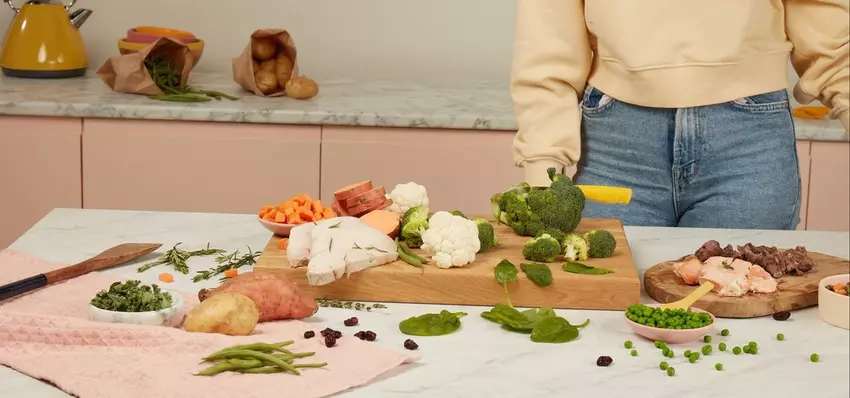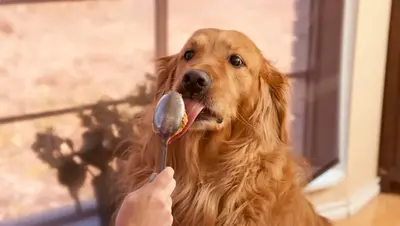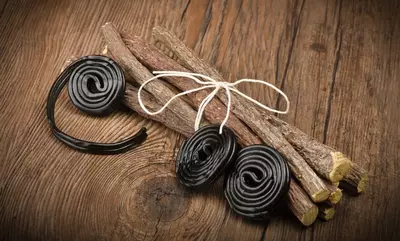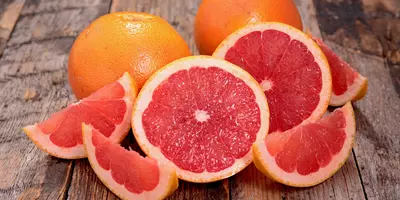15 of the Best Vegetables for Dogs
- 21 Dec 2019
- 5m read

Like us humans, dogs are omnivores. If you never ate a vegetable, your body would soon let you know it disapproved. Dogs are the same. You'd be forgiven for thinking that dog food is all about the meat. In part, it is. But the other – really impawtant – part is veg. It’s all about the balance. Dogs rely on all kinds of nutrients that come from different foods, as well as enjoying the diverse flavours and textures.
What Vegetables Can Dogs Eat?
You should always be careful when introducing new foods to your pup, slow and steady wins the race and all that jazz. Start with small tasters before adding any vegetables into a dog's diet long-term, just to ensure that it has your pooch’s seal of approval. The following veg are all suitable for dogs to eat in controlled quantities, according to PDSA.
• Carrots
• Peas
• Broccoli
• Parsnips
• Spinach
• Kale
• Brussel sprouts
• Peppers
• Beetroot
• Celery
• Cucumber
What Vegetables are Bad for Dogs?
Now, before you go feeding your pooch everything but the kitchen sink, it is crucial that you are aware of which vegetables to avoid. These toxic tummy-turners can cause a wide-range of nasty side effects including vomiting, diarrhoea and confusion, as well as damage to the nervous system, kidneys and digestive tract.
If you think your dog has ingested any of the following vegetables we recommend getting in touch with a vet immediately, just to be on the safe side. If you subscribe to Butternut Box, you can also use our free, 24/7 Vet Nurse helpline.
• Onions
• Garlic
• Leeks
• Mushrooms
• Asparagus
• Corn on the cob (sweetcorn is fine but the cob is a choking hazard)
• Tomatoes (yes we know, they’re technically a fruit)
• Rhubarb
Benefits of Feeding Your Dog Vegetables
Weight management
As well as being a tasty treat, including veg in your pooch's diet is an excellent way to control their weight.
Complex carbs and high-fibre vegetables take longer to digest, which may help keep your dog feeling fuller for longer. So if your furry friend is verging on the chunky side , making sure they eat plenty of delicious vegetables can help them slim down. Some pet parents like to give vegetables like carrots or broccoli as low-calorie snacks. So next time your pup gives you the eyes, maybe opt for a tasty piece of veg over a meaty treat.
Promotes healthy teeth and gums
Vegetables are fibre-rich, which makes them really good at helping keep teeth clean and prevent decay. Their sweet taste and crunchy texture also means that they go down a treat. A pawfect alternative if you want to cut out processed chews.
Daily dose of vitamins and minerals
Vegetables contain a lot of vitamins and minerals which often aren’t found in other food sources, making them a much-needed addition to a dog’s diet, according to AKC. Some of those most commonly found in veg are:
Vitamin C
Helps to maintain healthy skin, blood vessels and bones
Vitamin K
Helps blood to clot when wounds occur, starting the healing process
Vitamin A
Helps the immune system to fight against illness and infection
Magnesium
Helps in the process of turning food into energy
Iron & Folate
Helps the body to form healthy red blood cells
Calcium
Helps to build strong bones and prevent arthritis
How to Prepare Vegetables for Dogs
The first step to take when feeding your dog vegetables is to thoroughly wash them to get rid of any dirt and pesticides that may be lingering. You should also avoid adding any flavouring, such as butter, oil or salt. Once they’re squeaky clean there are a number of different ways you can serve them. We’ve listed the following methods suitable for dogs.
*chefs kiss*
Steamed
Steaming is one of the best ways to cook veg so it retains flavour and most of the nutrients. This method adds moisture too, making them even juicer and more delicious for your pup. To steam, place a steamer pot on top of a pan of boiling water and cover with a lid, allowing it to cook for five to six minutes on a medium heat.
Blanched
This method is the perfect way to rid veg of any harmful bacteria whilst keeping them as near to their raw state as possible. Blanching involves adding veg to a pot of boiling water for one to two minutes, then removing them from the pot and submerging them in a bowl of iced water which stops the cooking process.
Boiled
Boiling is definitely the most convenient way of cooking vegetables, but a lot of the water-soluble nutrients, like vitamin c, can be lost this way. If you’re going to opt for this method, we recommend saving the water and pouring some over your dog's evening meal (when cooled) to ensure that no goodness is wasted. To boil, simply add veg to a pan of boiling water and simmer for three to twelve mins depending on the veg.
Pureed
Pureeing vegetables makes them soft, meaning they are easy to swallow and digest which is great for elderly dogs, or those with digestive issues such as irritable bowel syndrome.
Can Dogs Eat Raw Vegetables?
Most vegetables can be given to dogs raw, as long as they’re washed and cut into bite-sized pieces (depending on the size of your dog) to minimise the risk of choking. However, there are a few outliers which should not be eaten raw, such as potatoes (sweet and ordinary) and beetroot.
Vegetables in Butternut Box’s Fresh Meals
Butternut Box recipes are made with carefully selected ingredients such as human-quality meat and – fanfare, please – freshly prepared vegetables. You might not have thought about giving your dog vegetables before, but they're a key part of every pup's diet. So to make sure tails are set to hyper-wag, it's vital to choose doggie meals with balanced ingredients.
Butternut Box uses a very clever, top-secret algorithm that takes your dog's vital statistics and calculates exactly how many calories they need to stay on top of their squirrel-chasing game.
We deliver your chosen recipes in pre-portioned pouches, each one being a perfectly sized, balanced meal. We don't use ruff estimates here. Working hand-in-paw with nutrition experts, we've developed our special system to determine the correct percentages for your dog's unique needs.

.webp)


